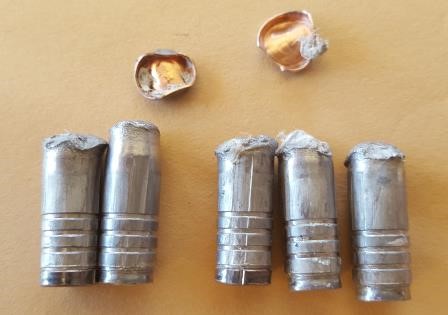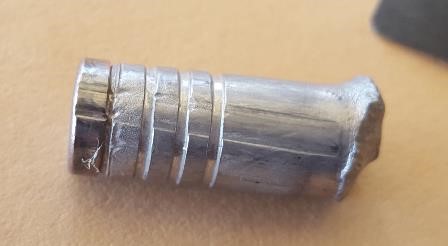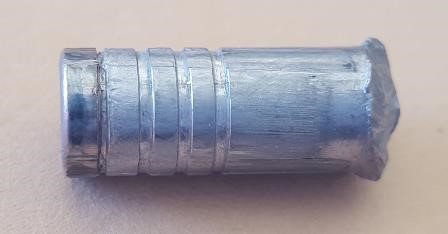Response by Ken Mollohan
Actually, I think we have some very good evidence concerning what a 'lube' does in a cast bullet load. Consider the following:
1. Unlubricated lead bullets (even though dead soft) can be fired without leading at fairly substantial velocities in air rifles.
2. Dr. Mann (and a few others) have obtained decent results with unlubricated bullets, but only under conditions with fillers or when the bullet was a very precise fit in the throat.
3. Otherwise, unlubricated cast bullets can be used in a firearm without leading ONLY if velocities are kept low.
4. Unlubricated cast bullets can be fired all day long (even at high velocities) without any evidence of leading with Cream of Wheat (and other fine granular materials) as fillers.
5. I have noticed on many occasions that the appearance of leading and lead flashing at the muzzle (when shooting normal lubricated bullets) coincided with substantial enlargement of the land marks on recovered bullets. These enlargements can be shown to originate with the side of the land that pushes the bullet to rotate it, because flame etching marks on the bullet grooves are noticeably longer and more severe on the NON-pushing sides.
Notice the pattern here: Every single instance where bare lead can be used successfully is under some condition that eliminates or minimizes the exposure of the projectile to flame. In example one, there is no flame (unless you are getting dieseling).
In example two, the base of the bullet is exposed, but not the sides -and the velocities are generally low enough to avoid abrasive enlargement of the grooves.
In example three, loads are light, and so is the pressure (and flame temperature) trying to get past the bullet.
In example four, the fillers have been shown to form exceedingly effective and solid firewall structures behind the bullet.
Once, many, many years ago, I tried to find out what was causing leading. The theories of the time included lead 'rubbing off' on the steel and similar absurdities. I tried just about everything you can imagine to make lead adhere to clean steel: Compression in a hydraulic press to 60,000 PSI wouldn't do it. Rubbing the lead on smooth steel wouldn't do it. Rubbing it on rough steel would remove the lead, but it was just a loose, non-adherent dust. Spinning the bullet against the steel using a variety of drills, etc left nothing that wouldn't wipe off with the finger. So bullet velocity wasn't the problem. In short, I have not found any set of conditions that will produce leading that does not involve flames - or at least high temperatures. All the evidence that I'm aware of seems to support a scenario that goes something like this:
Upon ignition, the gunpowder quickly converts into a ball of incandescent gas at high pressure which drives it against the base of the bullet. If the load is light, and/or if the bullet is a very good fit in the throat, the gas cannot leak past in significant volume to do any damage, so the load is reasonably successful. However, as the load is increased, velocities and pressures also increase. If the bullet is not a press fit in the throat, some gas will escape around the bullet before it begins to move. Abrasive land enlargement becomes significant, and opens channels along the bullet for flame to escape. This flame can easily exceed the melting point of steel, and it has little trouble etching low melting lead alloy from the sides of the bullet. These molten droplets of etching are blown forward of the bullet, and then are ironed onto the steel wall of the bore as the bullet passes.
(Now step aside for a moment, and go talk to someone with some experience with welding or soldering. They'll tell you that even the slightest trace of grease or oil on their materials will reduce or even prevent adhesion, and that for a good job, the metal MUST be clean as a whistle!)
I believe that - with reasonable loads -'lubricants' prevent this by fouling the steel bore, reducing the surface tension, and preventing the molten alloy from wetting and adhering to the bore.
However, as loads are increased even further, several factors begin to act against the lubricant. For one thing, as temperature of the flame goes up, so does the temperature of the lead etch droplets - and their surface tension goes down accordingly. Eventually, their surface tension will be lower than that of the lube, and the droplets will be able to adhere to the steel. (The weld / solder expert above doesn't even begin to work with temperatures like these!) Also, many waxes and wax like materials will completely evaporate at high enough temperatures, and some of them may not be able to stay around long enough to wet the steel.
There's a lot more evidence that I could cite, but the short version is that- I believe-'lubricants' really don't lubricate anything. They just contaminate the steel surface and prevent lead from being soldered to the bore. Does anyone have anything they think I'm overlooking?
























